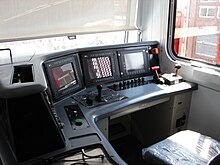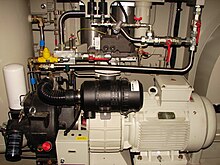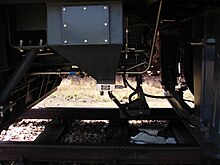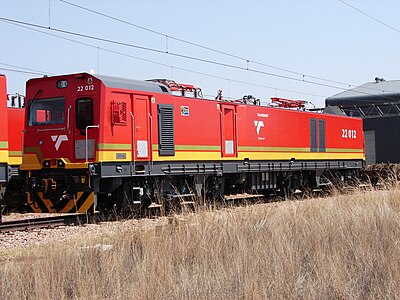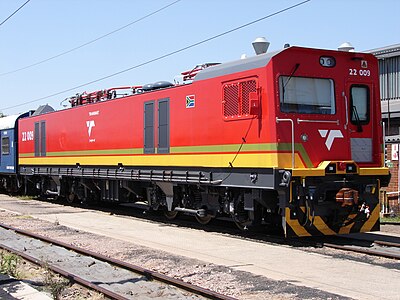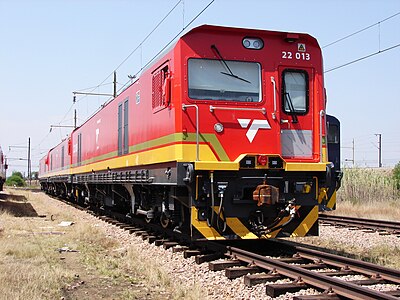TFR class 22E
| TFR class 22E | |
|---|---|
|
22 020 during testing at Pyramid South on September 22, 2015
|
|
| Numbering: | 22 001 - 22 359 |
| Number: | 359 |
| Manufacturer: | CSR Corporation |
| Year of construction (s): | 2015– |
| Axis formula : | Co'Co ' |
| Gauge : | 1067 mm ( cape track ) |
| Length over coupling: | 20,700 mm |
| Continuous output : | 4.6 MW |
| Power system : | 25 kV 50 Hz ~ 3 kV = |
| Number of traction motors: | 6th |
| Drive: | Pawbearing drive |
The Transnet Freight Rail Class 22E is from 2015, commissioned in six-axis dual-system - electric locomotive for freight of Transnet Freight Rail in South Africa . The locomotive was designed by the Chinese CSR Corporation and is designed to operate on 3 kV direct current and 25 kV 50 Hz alternating current.
Manufacturer
The first 40 class 22E locomotives were built in China at the Zhuzhou Electric Locomotive Company , which is a subsidiary of the China South Locomotive and Rolling Stock Corporation (CSR). The roll-out celebration of the first locomotive, the 22 002, took place on April 10, 2015. The remaining 359 locomotives will be built in South Africa near Pretoria in the maintenance workshop Koedoespoort by Transnet Engineering , a subsidiary of Transnet responsible for the maintenance of the rolling stock.
The purchase of the 22E series is part of the largest ever awarded supply contract for locomotives in South African history, which is also the largest single investment ever made by a South African company. The contract consists of four individual contracts with globally active rail vehicle manufacturers for the construction of a total of 1064 locomotives. They are:
- CSR Zhuzhou Electric Locomotive Company for 359 two-system TFR class 22E electric locomotives.
- Bombardier Transportation for 240 two-system electric locomotives of the TFR class 23E .
- GE Transportation for 233 TFR class 44 diesel-electric locomotives .
- China CNR Corporation for 232 TFR Class 45 diesel-electric locomotives .
The year of manufacture 2015 is entered on the nameplates of locomotives built in China, but for an unknown reason the plate of locomotive 22 041, the first locomotive built in South Africa, bears the year 2014.
Series designation
In the 1930s, when the South African Railways still operated steam locomotives, a heavier variant of SAR class 21 than SAR class 22 was proposed but never built. The class 22E is the first locomotive in South Africa with the number 22 in the designation.
technology
The locomotive body is a welded self-supporting structure made of sheet steel and profiles. The class 22E locomotives look practically the same as the class 20E and 21E locomotives , but are longer. They have six instead of four axes and a different arrangement of equipment in the engine room.
The locomotive has an output of 4.6 MW and is the second modern six-axle locomotive in the Transnet fleet after the locomotives for ore transport on the Sishen - Saldanha railway line .
Arrangement of the devices
The 22E locomotives only have a driver's cab at one end. In the engine room, the devices are arranged to the left and right of a central aisle. From front to back the arrangement is as follows:
Left side
|
right side
|
Pantograph
TFR insisted on arranging the pantographs in such a way that the pallet is directly above the pivot point of the bogie. The same arrangement was used on the 7E, 20E and 21E series locomotives . This reduces the risk of the pantograph getting caught in the contact line. This is particularly great in tunnels and narrow bends as well as with switches, because at these points the pantograph moves laterally in relation to the contact line.
Two-system operation
Like the two-system locomotives of the 19E, 20E and 21E series, the main circuit is automatically configured for direct current or alternating current operation depending on the existing contact line voltage . The phase protection sections and system change protection sections are three meters long and are signaled to the vehicle by track magnets 45 m before and after this section. The two magnets are laid with opposite polarities in relation to one another. You activate a reed switch , which is located behind the rail clearer of the locomotive and controls driving on the protective route.
When driving on a protective route, the pulling force is automatically switched off and the main switch is opened before it is reached. After driving over the protective section, the main switch is automatically closed again and the pulling force is switched on again.
photos
The pictures show the 20E locomotives from all sides.
Individual evidence
- ↑ a b c Railways Africa: Transnet's Class 22E Loco. In: Railways Africa. Retrieved April 2, 2016 .
- ↑ a b 中国 轨道 交通 装备 最大 出口 订单 开始 交付 _ 图片 _ 新闻 _ 中国 政府 网 (China's largest railway material export order begins shipping). gov.cn, accessed April 2, 2016 .
- ↑ William C. Vantuono: Transnet: 1,064 locomotives, $ 5 trillion. (No longer available online.) In: Railway Age. March 17, 2014, archived from the original on November 24, 2015 ; accessed on April 2, 2016 .
- ↑ South Africa's 'largest ever' locomotive order awarded to four suppliers. In: Railway Gazette. Retrieved April 2, 2016 .
- ^ The Steam Locomotives of the South African Railways: Sar Locos 1910–55 and Harbor Board Locos 1873–1904. David & Charles 1971, ISBN 978-0-360-00153-4 , ( books.google.com ).
- ↑ a b c d Xing Tao: Drawing SA22E-DW-CO, Rev A: Machine Room Equipment Arrangement . Ed .: ZELC. May 4, 2014.
- ^ Transnet tests diesel and electric locos. In: Railway Gazette. Retrieved April 2, 2016 .
- ↑ South African Railways Index and Diagrams Electric and Diesel Locomotives, 610 mm and 1065 mm Gauges, Ref LXD 14/1/100/20. January 28, 1975, and additions
- ^ A b Locomotive Profile and Technical Data . In: Class 20E manual . Part 1.


